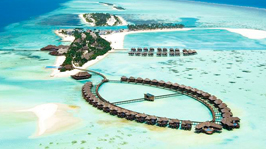Surfing
The Maldives has a great array of left and right reef breaks suiting most intermediate to advanced surfers. The Maldivian waves aren't generally as intense as Indo, the Mentawai's or Tahiti surf but like anywhere, any break over 6' and over reef deserves your respect! You can still pick up some small clean waves in the dry season of November to February but it is not regarded as part of the main swell period. It would still be worth packing your board. It is generally more suited to diving or spending quality time with that special partner!
In the North and South Male Atolls waves are best between February and October, peaking between March and August. The months of June, July and August are potentially the best months for the biggest swells but tropical storms are more prevalent. February, March, April and May have good swell consistency with more favourable weather conditions. North Male Atoll has the best known breaks such as Pasta Point, Chickens and Lohis and usually gets bigger swells than the South Male breaks. North Male atolls are more accessible due to the higher concentration of resorts. South Male waves usually break a bit smaller than those in the north, the waves are excellent and can be had with fewer people in the surf. The region is easily accessed by charter boat, with it being only a couple of hours sailing time from Male.
Central Atolls

The surf season in the Central Atolls runs from March to October when swells are produced by winter low pressure systems in the southern Indian Ocean. The predominant swell through-out the year come from the Southeast to Southwest with swell consistency and size vary from spot to spot during these months.
In general, March, April and May have very clean conditions, June to August the potential for the bigger swells and September and October are known as consistent swell months with variable wind conditions with the area's tropical storms starting to dissipate.Booking
North Male Atoll

The surf season in the North Male Atoll runs from March to October when swells are produced by winter low pressure systems in the southern Indian Ocean. Swell consistency and size vary from spot to spot during these months.
In general, March, April and May have very clean conditions, June to August the potential for the bigger swells and September and October are known as consistent swell months with variable wind conditions with the area's tropical storms starting to dissipate.Booking
South Male Atoll

The surf season in the South Male Atoll runs from March to October when swells are produced by winter low pressure systems in the southern Indian Ocean. Swell consistency and size vary from spot to spot during these months.
In general, March, April and May have very clean conditions, June to August the potential for the bigger swells and September and October are known as consistent swell months with variable wind conditions with the area's tropical storms starting to dissipate.Booking
Southern Atolls

It is surrounded by the Indian Ocean, Arabian and Laccadive Seas, which allows this atoll to pick up more swell than any other in the Maldives and in every direction. As this is a low lying country and is 99% made up of sea, It supports for an abundance of reef surfing.
The native language of the Maldives is called Dhivehi and is only spoken there, English maybe the second language but is high used especially for the consistent holiday makers and surf fanatics. Gaafu Dhaalu Atoll is nothing but beaches and waves, it is secluded and peaceful.Booking
